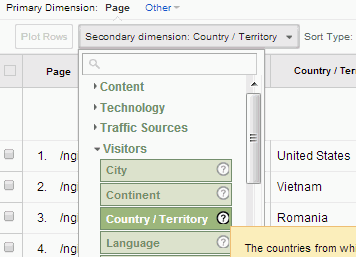Maximize Your Coverage with Secondary Dimension in Google Analytics
Maximize Your Coverage with Secondary Dimension in Google Analytics
Blog Article
Unlock Deeper Insights With Second Measurement in Google Analytics
With the vast area of data readily available in Google Analytics, the application of second dimensions can significantly enhance your analytical capabilities. These additional layers of data offer a nuanced point of view that can light up intricate information within your key metrics. By purposefully integrating additional measurements into your evaluation, you can unearth beneficial understandings that may otherwise remain undiscovered. The capability to interpret and dissect individual behavior with higher accuracy opens up a world of opportunities for improving and enhancing techniques performance.
Recognizing Key Vs. Additional Dimensions
When assessing information in Google Analytics, it is vital to compare additional and key dimensions to get deeper insights into user habits. Main dimensions are the major groups whereby you can watch your data, such as gadget, landing, or source/medium web page. These measurements offer the fundamental framework for organizing and recognizing your information. On the other hand, secondary dimensions allow you to more explore your main measurement data. By including a second dimension, you can layer on additional details to your main measurement, making it possible for a more granular analysis. If your key dimension is the source/medium through which users arrived on your site, including an additional dimension like geographic location can disclose where those individuals are situated geographically. When looking at the primary dimension alone, this added layer of details can help you recognize fads, patterns, or anomalies that may not have actually been apparent. For that reason, leveraging both secondary and primary measurements in Google Analytics is crucial for thorough data evaluation and informed decision-making.
Using Secondary Measurements Effectively
By incorporating additional dimensions along with main dimensions, marketers and analysts can delve much deeper into the specifics of user communications on their web sites. Secondary dimensions allow customers to section and filter primary measurement information further, supplying an extra thorough sight of customer interactions, behaviors, and demographics.
In addition, additional measurements enable customers to contrast and contrast different information points within a solitary report, assisting in a more detailed analysis of user habits patterns. By leveraging secondary dimensions properly, organizations can reveal covert understandings, enhance their marketing approaches, and enhance the total individual experience on their web sites.
Checking Out Typical Second Measurement Mixes
To even more examine user habits and trends in Google Analytics, it is important to check out usual combinations of additional measurements. Some common additional dimension mixes that provide valuable understandings include examining website traffic resources with customer areas to recognize where internet site visitors are coming from geographically and how they discovered the website. Analyzing customer actions metrics with second dimensions such as interests or demographics can help in targeting particular audience sections a lot more effectively.
Applying Secondary Measurement in Personalized News
Using second dimensions in custom records permits for a more thorough evaluation of data in Google Analytics, boosting the deepness of understandings gotten. When developing customized records in Google Analytics, including second dimensions can supply an extra in-depth view of just how numerous measurements engage with each various other. This feature enables individuals to dive deeper into their information and uncover important correlations that might not be right away evident.
By applying secondary dimensions in custom-made reports, individuals can obtain a far better understanding of their website or application web traffic. Integrating the primary dimension of "source/medium" Related Site with the secondary measurement of "landing web page" can expose which landing web pages are executing finest for web traffic coming from particular sources. This insight can help online marketers maximize their campaigns and boost total conversion prices.

Enhancing Information Visualization With Secondary Measurement
When exploring data in Google Analytics personalized records, integrating additional measurements not only offers an extra detailed analysis yet also improves the graph of understandings with data visualization. By adding an additional dimension to your reports, you can use this link improve the method data is offered, making it easier to identify patterns, fads, and my blog relationships within your web site's efficiency metrics.
Secondary dimensions can assist you segment your information better, enabling a much deeper understanding of customer actions and communications on your website. When trying to isolate specific variables that may influence your site's efficiency., this enhanced level of granularity can be especially helpful.

Final Thought
In conclusion, leveraging additional dimensions in Google Analytics permits a much more detailed evaluation of information, resulting in much deeper insights and even more informed decision-making. Secondary Dimension in Google Analytics. By including added layers of details to main information sets, marketers and experts can discover surprise patterns, patterns, and correlations that offer a granular view of user habits and communications. This enhanced degree of understanding enables optimization of projects and tailored methods for certain target market sections, eventually improving performance and conversion rates
On the various other hand, secondary measurements allow you to further explore your main dimension information. By adding a second measurement, you can layer on additional info to your primary dimension, making it possible for a more granular analysis. If your main measurement is the source/medium with which customers got here on your site, adding a secondary measurement like geographical location can expose where those customers are situated geographically. By integrating additional measurements alongside primary dimensions, online marketers and experts can dig deeper right into the specifics of user communications on their websites. Additional dimensions enable users to sector and filter main dimension information even more, supplying a more comprehensive sight of user interactions, behaviors, and demographics.
Report this page